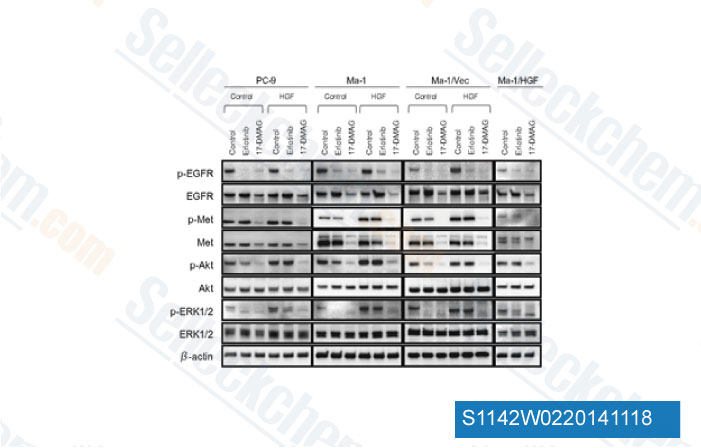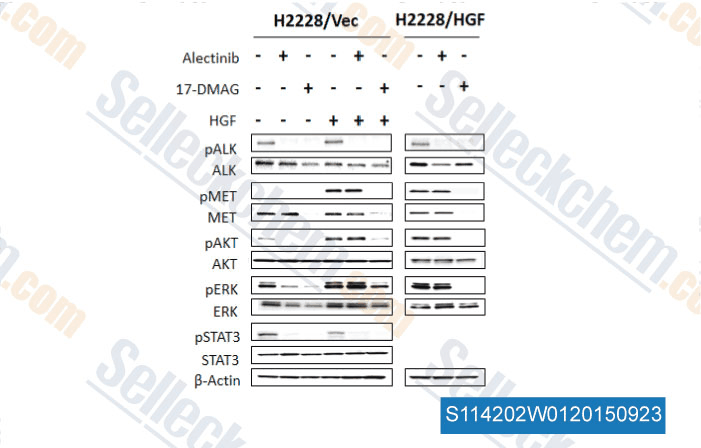|
Toll Free: (877) 796-6397 -- USA and Canada only -- |
Fax: +1-832-582-8590 Orders: +1-832-582-8158 |
Tech Support: +1-832-582-8158 Ext:3 Please provide your Order Number in the email. |
Technical Data
| Formula | C32H48N4O8•HCl |
|||
| Molecular Weight | 653.21 | CAS No. | 467214-21-7 | |
| Solubility (25°C)* | In vitro | DMSO | 131 mg/mL (200.54 mM) | |
| Water | Insoluble | |||
| Ethanol | Insoluble | |||
|
* <1 mg/ml means slightly soluble or insoluble. * Please note that Selleck tests the solubility of all compounds in-house, and the actual solubility may differ slightly from published values. This is normal and is due to slight batch-to-batch variations. * Room temperature shipping (Stability testing shows this product can be shipped without any cooling measures.) |
||||
Preparing Stock Solutions
Biological Activity
| Description | Alvespimycin (17-DMAG, NSC 707545, BMS 826476, KOS 1022) HCl is a potent HSP90 inhibitor with IC50 of 62 nM in a cell-free assay. | ||
|---|---|---|---|
| Targets |
|
||
| In vitro | 17-DMAG displays ~2 times potency against human Hsp90 than 17-AAG, with IC50 of 62 nM versus 119 nM. In SKBR3 and SKOV3 cells which over-express Hsp90 client protein Her2, 17-DMAG causes down-regulation of Her2 with EC50 of 8 nM and 46 nM, respectively, as well as induction of Hsp70 with EC50 of 4 nM and 14 nM, respectively, leading to significant cytotoxicity with GI50 of 29 nM and 32 nM, respectively, consistent with Hsp90 inhibition. [1] 17-DMAG in combination with vorinostat synergistically induces apoptosis of the cultured MCL cells as well as primary MCL cells, more potently than either agent alone, by markedly attenuating the levels of cyclin D1 and CDK4, as well as of c-Myc, c-RAF and Akt. [3] In contrast to 17-AAG which is only active for IKKβ in chronic lymphocytic leukemia (CLL) cells, 17-DMAG treatment effectively leads to depletion of the Hsp90 client protein, resulting in diminished NF-κB p50/p65 DNA binding, decreased NF-κB target gene transcription, and caspase-dependent apoptosis. By targeting the NF-κB family, 17-DMAG selectively mediates dose- and time-dependent cytotoxicity against CLL cells, but not normal T cells or NK cells important for immune surveillance. [5] |
||
| In vivo | 17-DMAG treatment at 5 mg/kg or 25 mg/kg thrice per week significantly reduces tumor growth of TMK-1 xenografts, by significantly reducing vessel area and numbers of proliferating tumor cells in sections. [2] Consistent the inhibition of FAK signaling in vivo, 17-DMAG treatment at 25 mg/kg three times a week significantly suppresses tumor growth, and metastasis of ME180 and SiHa xenografts in mice. [4] Administration of 17-DMAG at 10 mg/kg for 16 days significantly decreases the white blood cell count and prolongs the survival in a TCL1-SCID transplant mouse model. [5] |
||
| Features | A synthetic derivative Geldanamycin, with lower hepatotoxicity than parent antibiotic & higher potency and bioavailability than the similar derivative 17-AAG. |
Protocol (from reference)
| Kinase Assay: |
|
|---|---|
| Cell Assay: |
|
| Animal Study: |
|
References
Customer Product Validation

-
Data from [Data independently produced by Mol Oncol, 2013, 7(6), 1093-102]

-
Data from [Data independently produced by J Thorac Oncol, 2012, 7(7), 1078-85]

-
Data from [Data independently produced by J Thorac Oncol, 2012, 7(7), 1078-85]

-
Data from [Data independently produced by , , Oncotarget, 2014, 5(13): 4920-28 ]
Selleck's Alvespimycin (17-DMAG) HCl has been cited by 68 publications
| Stress response silencing by an E3 ligase mutated in neurodegeneration [ Nature, 2024, 626(8000):874-880] | PubMed: 38297121 |
| Cytokine-Induced Killer Cells in Combination with Heat Shock Protein 90 Inhibitors Functioning via the Fas/FasL Axis Provides Rationale for a Potential Clinical Benefit in Burkitt's lymphoma [ Int J Mol Sci, 2023, 24(15)12476] | PubMed: 37569852 |
| Role of heat shock protein 90 as an antiviral target for swine enteric coronaviruses [ Virus Res, 2023, 329:199103] | PubMed: 36963723 |
| Heat shock protein 90 facilitates SARS-CoV-2 structural protein-mediated virion assembly and promotes virus-induced pyroptosis [ J Biol Chem, 2023, 299(5):104668] | PubMed: 37011862 |
| Alvespimycin Inhibits Heat Shock Protein 90 and Overcomes Imatinib Resistance in Chronic Myeloid Leukemia Cell Lines [ Molecules, 2023, 28(3)1210] | PubMed: 36770876 |
| Local Elimination of Senescent Cells Promotes Bone Defect Repair during Aging [ ACS Appl Mater Interfaces, 2022, 10.1021/acsami.1c22138] | PubMed: 35014784 |
| Inflammation accelerates BCR-ABL1+ B-ALL development through upregulation of AID [ Blood Adv, 2022, 6(13):4060-4072] | PubMed: 35816360 |
| Hsp90 Regulates GCRV-II Proliferation by Interacting with VP35 as Its Receptor and Chaperone [ J Virol, 2022, 96(19):e0117522] | PubMed: 36102647 |
| Hsp90 Regulates GCRV-II Proliferation by Interacting with VP35 as Its Receptor and Chaperone [ Journal of Virology, 2022, Vol. 96, No. 19] | PubMed: None |
| Therapeutic Response Monitoring with 89Zr-DFO-Pertuzumab in HER2-Positive and Trastuzumab-Resistant Breast Cancer Models [ Pharmaceutics, 2022, 14(7)1338] | PubMed: 35890234 |
RETURN POLICY
Selleck Chemical’s Unconditional Return Policy ensures a smooth online shopping experience for our customers. If you are in any way unsatisfied with your purchase, you may return any item(s) within 7 days of receiving it. In the event of product quality issues, either protocol related or product related problems, you may return any item(s) within 365 days from the original purchase date. Please follow the instructions below when returning products.
SHIPPING AND STORAGE
Selleck products are transported at room temperature. If you receive the product at room temperature, please rest assured, the Selleck Quality Inspection Department has conducted experiments to verify that the normal temperature placement of one month will not affect the biological activity of powder products. After collecting, please store the product according to the requirements described in the datasheet. Most Selleck products are stable under the recommended conditions.
NOT FOR HUMAN, VETERINARY DIAGNOSTIC OR THERAPEUTIC USE.
